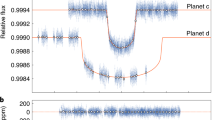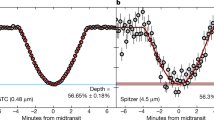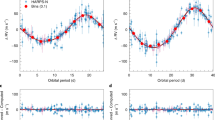Abstract
Extrasolar planets that pass in front of their host star (transit) cause a temporary decrease in the apparent brightness of the star, providing a direct measure of the planet’s size and orbital period. In some systems with multiple transiting planets, the times of the transits are measurably affected by the gravitational interactions between neighbouring planets1,2. In favourable cases, the departures from Keplerian orbits (that is, unaffected by gravitational effects) implied by the observed transit times permit the planetary masses to be measured, which is key to determining their bulk densities3. Characterizing rocky planets is particularly difficult, because they are generally smaller and less massive than gaseous planets. Therefore, few exoplanets near the size of Earth have had their masses measured. Here we report the sizes and masses of three planets orbiting Kepler-138, a star much fainter and cooler than the Sun. We determine that the mass of the Mars-sized inner planet, Kepler-138 b, is  Earth masses. Its density is
Earth masses. Its density is  grams per cubic centimetre. The middle and outer planets are both slightly larger than Earth. The middle planet’s density (
grams per cubic centimetre. The middle and outer planets are both slightly larger than Earth. The middle planet’s density ( grams per cubic centimetre) is similar to that of Earth, and the outer planet is less than half as dense at
grams per cubic centimetre) is similar to that of Earth, and the outer planet is less than half as dense at  grams per cubic centimetre, implying that it contains a greater portion of low-density components such as water and hydrogen.
grams per cubic centimetre, implying that it contains a greater portion of low-density components such as water and hydrogen.
This is a preview of subscription content, access via your institution
Access options
Subscribe to this journal
Receive 51 print issues and online access
$199.00 per year
only $3.90 per issue
Buy this article
- Purchase on Springer Link
- Instant access to full article PDF
Prices may be subject to local taxes which are calculated during checkout


Similar content being viewed by others
References
Agol, E., Steffen, J., Sari, R. & Clarkson, W. On detecting terrestrial planets with timing of giant planet transits. Mon. Not. R. Astron. Soc. 359, 567–579 (2005)
Holman, M. J. & Murray, N. W. The use of transit timing to detect terrestrial-mass extrasolar planets. Science 307, 1288–1291 (2005)
Holman, M. J. et al. Kepler-9: a system of multiple planets transiting a Sun-like star, confirmed by timing variations. Science 330, 51–54 (2010)
Borucki, W. J. et al. Characteristics of planetary candidates observed by Kepler. II. Analysis of the first four months of data. Astrophys. J. 736, 19–40 (2011)
Batalha, N. M. et al. Planetary candidates observed by Kepler. III. Analysis of the first 16 months of data. Astrophys. J. 204 (Suppl.), 24–44 (2013)
Burke, C. J. et al. Planetary candidates observed by Kepler IV: planet sample from Q1–Q8 (22 months). Astrophys. J. 210 (Suppl.), 19–30 (2014)
Pepe, F. et al. An Earth-sized planet with an Earth-like density. Nature 503, 377–380 (2013)
Howard, A. W. et al. A rocky composition for an Earth-sized exoplanet. Nature 503, 381–384 (2013)
Cochran, W. D. et al. Kepler-18b, c and d: a system of three planets confirmed by transit timing variations, light curve validation, warm Spitzer photometry, and radial velocity measurements. Astrophys. J. 197 (Supp.), 7–25 (2011)
Steffen, J. H, et al. Transit timing observations from Kepler. III. Confirmation of four multiple planet systems by a Fourier-domain study of anticorrelated transit timing variations. Mon. Not. R. Astron. Soc. 421, 2342–2354 (2012)
Ford, E. B. et al. Transit timing observations from Kepler. V. Transit timing variation candidates in the first sixteen months from polynomial models. Astrophys. J. 756, 185–191 (2012)
Steffen, J. H. et al. Transit timing observations from Kepler. VI. Potentially interesting candidate systems from Fourier-based statistical tests. Astrophys. J. 756, 186–190 (2012)
Lithwick, Y., Xie, J. & Wu, Y. Extracting planet mass and eccentricity from TTV data. Astrophys. J. 761, 122–132 (2012)
Wu, Y. & Lithwick, Y. Density and eccentricity of Kepler planets. Astrophys. J. 772, 74–86 (2013)
Jontof-Hutter, D., Lissauer, J. J., Rowe, J. F. & Fabrycky, D. C. Kepler-79’s low density planets. Astrophys. J. 785, 15–18 (2014)
Lissauer, J. J. et al. All six planets known to orbit Kepler-11 have low densities. Astrophys. J. 770, 131–145 (2013)
Masuda, K. Very low density planets around Kepler-51 revealed with transit timing variations and an anomaly similar to a planet-planet eclipse event. Astrophys. J. 783, 53–60 (2014)
Ofir, A., Dreizler, S., Zechmeister, M. & Husser, T.-O. An independent planet search in the Kepler dataset. II. An extremely low-density super-Earth mass planet around Kepler-87. Astron. Astrophys. 561, A103 (2014)
Carter, J. A. et al. Kepler-36: a pair of planets with neighboring orbits and dissimilar densities. Science 337, 556–559 (2012)
Rowe, J. F. et al. Validation of Kepler's multiple planet candidates. III. Light curve analysis and announcement of hundreds of new multi-planet systems. Astrophys. J. 784, 45–64 (2014)
Kipping, D. M. et al. The hunt for exomoons with Kepler (HEK). IV. A search for moons around eight M dwarfs. Astrophys. J. 784, 28–42 (2014)
Bodenheimer, P. & Lissauer, J. J. Accretion and evolution of ∼2.5 Earth-mass planets with voluminous H/He envelopes. Astrophys. J. 791, 103–134 (2014)
Lopez, E. D. & Fortney, J. J. The role of core mass in controlling evaporation: the Kepler radius distribution and the Kepler-36 density dichotomy. Astrophys. J. 776, 2–12 (2013)
Owen, J. E. & Wu, Y. Kepler planets: a tale of evaporation. Astrophys. J. 775, 105–116 (2013)
Ferraz-Mello, S., Tadeu Dos Santos, M., Beaugé, C., Michtchenko, T. A. & Rodríguez, A. On the mass determination of super-Earths orbiting active stars: the CoRoT-7 system. Astron. Astrophys. 531, A161 (2011)
Batalha, N. M. et al. Kepler’s first rocky planet: Kepler-10b. Astrophys. J. 729, 27–47 (2011)
Fressin, F. G. et al. Two Earth-sized planets orbiting Kepler-20. Nature 482, 195–198 (2011)
Gautier, T. N., III et al. Kepler-20: a Sun-like star with three sub-Neptune exoplanets and two Earth-size candidates. Astrophys. J. 749, 15–33 (2012)
Weiss, L. M. et al. The mass of KOI-94d and a relation for planet radius, mass, and incident flux. Astrophys. J. 768, 14–32 (2013)
Marcy, G. W. et al. Masses, radii, and orbits of small Kepler planets: the transition from gaseous to rocky planets. Astrophys. J. 210 (Suppl.), 20–89 (2014)
Mandel, K. & Agol, E. Analytic light curves for planetary transit searches. Astrophys. J. 580, L171 (2002)
Muirhead, P. S. et al. Characterizing the cool Kepler objects of interest. New effective temperatures, metallicities, masses and radii of low-mass Kepler planet-candidate host stars. Astrophys. J. 750, L37 (2012)
Claret, A. & Bloeman, S. Gravity and limb-darkening coefficients for the Kepler, CoRoT, Spitzer, uvby, UBVRIJHK, and Sloan photometric systems. Astron. Astrophys. 529, A75 (2011)
Seager, S. & Mallen-Ornelas, G. A unique solution of planet and star parameters from an extrasolar planet transit light curve. Astrophys. J. 585, 1038–1055 (2003)
Dotter, A. The Dartmouth Stellar Evolution Database. Astrophys. J. 178 (Suppl.), 89–101 (2008)
Pineda, J. S., Bottom, M. & Johnson, J. A. Using high resolution optical spectra to measure intrinsic properties of low-mass stars: new properties for KOI-314 and GJ 3470. Astrophys. J. 767, 28–38 (2013)
Delfosse, X. et al. Accurate masses of very low mass stars. IV. Improved mass-luminosity relations. Astron. Astrophys. 364, 217–224 (2000)
Boyajian, T. S. et al. Stellar diameters and temperatures. II. Main sequence K- and M-stars. Astrophys. J. 757, 112–142 (2012)
Lissauer, J. J. et al. A closely packed system of low-mass, low-density planets transiting Kepler-11. Nature 470, 53–58 (2011)
Ter Braak, C. A Markov Chain Monte Carlo version of the genetic algorithm Differential Evolution: easy Bayesian computing for real parameter spaces. Stat. Comput. 16, 239–249 (2006)
Nelson, B., Ford, E. B. & Payne, M. J. RUN DMC: an efficient, parallel code for analyzing radial velocity observations using N-body integrations and Differential Evolution Markov Chain Monte Carlo. Astrophys. J. 210 (Suppl.), 11–23 (2014)
Ford, E. Quantifying the uncertainty in the orbits of extrasolar planets. Astron. J. 129, 1706–1717 (2005)
Tegmark, M. et al. Cosmological parameters from SDSS and WMAP. Phys. Rev. D 69, 103501 (2004)
Fortney, J. J., Marley, M. S. & Barnes, J. W. Planetary radii across five orders of magnitude in mass and stellar insolation: application to transits. Astrophys. J. 659, 1661–1672 (2007)
Zeng, L. & Sasselov, D. A detailed model grid for solid planets from 0.1 through 100 Earth masses. Publ. Astron. Soc. Pacif. 125, 227–239 (2013)
Rauch, K. P. & Hamilton, D. P. HNBody: Hierarchical N-Body Symplectic Integration Package. In Astrophysics Source Code Library. http://ascl.net/1201.010 (2012)
Goldreich, P. & Tremaine, S. Precession of the epsilon ring of Uranus. Astron. J. 84, 1638–1641 (1979)
Chiang, E. I. & Goldreich, P. Apse alignment of narrow eccentric planetary rings. Astrophys. J. 540, 1084–1090 (2000)
Chiang, E. I., Tabachnik, S. & Tremaine, S. Apsidal alignment in Upsilon Andromedae. Astron. J. 122, 1607–1615 (2001)
Rivera, E. J., Laughlin, G., Butler, R. P., Vogt, S. S. & Haghighipour, N. The Lick-Carnegie Exoplanet Survey. A Uranus-mass fourth planet for GJ 876 in an extrasolar Laplace configuration. Astrophys. J. 719, 890–899 (2010)
Nelson, B. E. et al. The 55 Cancri planetary system: fully self-consistent N-body constraints and a dynamical analysis. Mon. Not. R. Astron. Soc. 441, 442–451 (2014)
Verdinelli, I. & Wasserman, L. Computing Bayes factors using a generalization of the Savage-Dickey density ratio. J. Am. Stat. Assoc. 90, 614–618 (1995)
Hadden, S. & Lithwick, Y. Densities and eccentricities of 139 Kepler planets from transit timing variations. Astrophys. J. 787, 80–87 (2014)
Moorhead, A. V. et al. The distribution of transit durations for Kepler planet candidates and implications for their orbital eccentricities. Astrophys. J. 197 (Suppl.), 1–15 (2011)
Fabrycky, D. C. et al. Architecture of Kepler’s multi-transiting systems. II. New investigations with twice as many candidates. Astrophys. J. 790, 146–157 (2014)
Lissauer, J. J. et al. Architecture and dynamics of Kepler’s candidate multiple transiting planet systems. Astrophys. J. 197, 8–33 (2011)
Acknowledgements
D.J-H. acknowledges support through the NASA Postdoctoral Program and funding from the Center for Exoplanets and Habitable Worlds. The Center for Exoplanets and Habitable Worlds is supported by the Pennsylvania State University, the Eberly College of Science and the Pennsylvania Space Grant Consortium. J.F.R. acknowledges NASA grant NNX14AB92G issued through the Kepler Participating Scientist Program. D.C.F. is an Alfred P. Sloane Fellow and was supported by the Kepler Participating Scientist Program award NNX14AB87G. E.B.F. was supported in part by NASA Kepler Participating Scientist Program award NNX14AN76G and NASA Exoplanet Research Program award NNX15AE21G, as well as the Center for Exoplanets and Habitable Worlds.
Author information
Authors and Affiliations
Contributions
D.J.-H. led the research effort to model the TTV, constrain planetary masses, and wrote the manuscript. J.F.R. measured transit times from the Kepler data set, characterized the host star using spectral follow-up of the target and constraints from the transits and edited the manuscript. J.J.L. led the interpretation effort, assisted in the dynamical study and writing the manuscript. D.C.F. wrote the software to simulate planetary transits, assisted in interpreting results and edited the manuscript. E.B.F. assisted in the development of statistical methodologies and robustness tests for the TTV modelling and edited the manuscript.
Corresponding author
Ethics declarations
Competing interests
The authors declare no competing financial interests.
Extended data figures and tables
Extended Data Figure 1 Folded light curves with corrections for observed TTV for Kepler-138.
The scattered points are photometric relative fluxes and the curves are analytical models of the transit shape described in the text. a, Kepler-138 b; b, Kepler-138 c; c, Kepler-138 d.
Extended Data Figure 2 Stellar mass and radius models using constraints on the stellar mean density inferred from the light curve.
In cyan are models that adopted a uniform prior in eccentricity, and in magenta are constraints found with orbital eccentricities fixed at zero. Grey points with error bars mark stellar parameters found in the literature while the black error bars mark our adopted solution for stellar mass and radius.
Extended Data Figure 3 The distribution of residual normalized deviations from our best fit dynamical model to the raw transit times.
The histogram marks deviations calculated as: (O − S)/σTT, where O is the observed transit time, S is the simulated transit time and σTT is the measurement uncertainty. The green curve marks a Gaussian distribution.
Extended Data Figure 4 Posterior distributions for TTV model parameters.
Data are shown for our nominal model. a, The planet-to-star mass ratio (Mp/M★) for Kepler-138 b; b, Mp/M★ for Kepler-138 c; c, Mp/M★ for Kepler-138 d. d, ecosω for Kepler-138 b; e, ecosω for Kepler-138 c; f, ecosω for Kepler-138 d. g, esinω for Kepler-138 b; h, esinω for Kepler-138 c; i, esinω for Kepler-138 d. The relative frequency for each histogram is scaled to the mode. Mass ratios are scaled to the M⊙/M⊕ mass ratio.
Extended Data Figure 5 Joint posteriors of model parameters and the effects of eccentricity priors.
The dark (light) grey marks the 68.3% (95.4%) credible intervals for each joint posterior. a–c, Mp/M★ and eccentricity vector components for the inner and middle planets. d–f, Mp/M★ and eccentricity vector components for the middle and outer planets. Panels g, h and i compare Kepler-138 b’s Mp/M★ and its orbital eccentricity, for three eccentricity priors: a uniform prior on eccentricity (g), and models with a Rayleigh distribution of scale factor 0.1 (h), and 0.02 (i).
Extended Data Figure 6 Posterior distributions for mass ratios and relative eccentricities between planets.
The mass ratio of the inner and middle planets is shown in a, and relative eccentricity vector components—that is, the difference in ecosω (esinω) in the inner pair—are shown in b (c). The mass ratio of the middle and outer planets are plotted in d, and the relative eccentricity vector components—that is, the difference in ecosω (esinω) in the outer pair—are shown in e (f).
Extended Data Figure 7 Sensitivity tests for the effects of eccentricity prior, outlying transit times and free inclinations on the mass of Kepler-138 b relative to the host star.
Panel a compares a uniform prior (black curve, our nominal posterior for all comparisons) and a Rayleigh distribution with scale factors 0.1 (navy) and 0.02 (cyan). Panel b compares posteriors with 3σ outliers excluded (black), with two alternatives: 4σ outliers (blue) and 2.5σ outliers removed (light green). Panel c compares our nominal model with one with a free ascending node for the inner (purple) or outer (red) planet.
Extended Data Figure 8 Validation of our method with synthetic data sets.
The green curve marks the posterior for a synthetic data set generated with the same parameters as were the medians of our nominal posteriors (in Table 1). The agreement between the green and black curves validates our method and our claim for a positive mass detection for Kepler-138 b. The magenta and purple shades are posteriors for models using data generated with zero mass for Kepler-138 b. These zero-mass synthetic models all reproduced non-detections.
PowerPoint slides
Rights and permissions
About this article
Cite this article
Jontof-Hutter, D., Rowe, J., Lissauer, J. et al. The mass of the Mars-sized exoplanet Kepler-138 b from transit timing. Nature 522, 321–323 (2015). https://doi.org/10.1038/nature14494
Received:
Accepted:
Published:
Issue Date:
DOI: https://doi.org/10.1038/nature14494
This article is cited by
-
Observational Constraints on the Formation and Evolution of Neptune-Class Exoplanets
Space Science Reviews (2020)
-
Three eras of planetary exploration
Nature Astronomy (2017)
-
Indexing of exoplanets in search for potential habitability: application to Mars-like worlds
Astrophysics and Space Science (2017)
-
Insights into Planet Formation from Debris Disks
Space Science Reviews (2016)
-
Consequences of tidal interaction between disks and orbiting protoplanets for the evolution of multi-planet systems with architecture resembling that of Kepler 444
Celestial Mechanics and Dynamical Astronomy (2016)
Comments
By submitting a comment you agree to abide by our Terms and Community Guidelines. If you find something abusive or that does not comply with our terms or guidelines please flag it as inappropriate.



